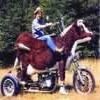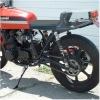Manometer idea for carb sync's
- steell
-

- Offline
- User
-

Registered
- Posts: 6849
- Thanks: 208
Re: Manometer idea for carb sync's
04 May 2006 00:09
loudhvx wrote:
I'll give it a try on my twin when I get it back together, I caught the "While I'm there" virus
I think that would be ok on a twin, but I'm not to sure about syncing carbs that way on a four.I don't like the fact that it looks like it's a "differential pair" manometer rather than one using atmosphere as a reference.
I'll give it a try on my twin when I get it back together, I caught the "While I'm there" virus

KD9JUR
Please Log in or Create an account to join the conversation.
- bemoore
-

- Offline
- User
-

Registered
- Posts: 190
- Thanks: 4
Re: Manometer idea for carb sync's
04 May 2006 05:46
steell wrote:
I have a 77 KZ650C (not sure which carbs), and I have just reassembled them after a cleaning. So I have looked at the actual linkage and mine don't work like yours. There is a single shaft that goes through all the carbs and works each slide. Each slide has its own adjuster, so for me it would make more sense to adjust 1-2, then 1-3, then 1-4, of course leaving #1 alone for all these adjustments.OKC_Kent, if you look at the actual linkage on the carbs I think it will be easy to understand.
It's one of those things that's hard to explain, but obvious when you look at it
77 KZ650C1 w/Kerker 4-1
Please Log in or Create an account to join the conversation.
- loudhvx
-

- Offline
- KZr Legend
-

Registered
- Posts: 10864
- Thanks: 1619
Re: Manometer idea for carb sync's
04 May 2006 06:40
My problem with the differential pair is if it's used for asymmetrical pairs. Momentum of the water becomes a factor. For 360 degree twins it's ok, but not for 180 degree motors like the Honda CB 350's etc. I thought some of the later KZ twins had 180 degree motors, no?
The differential pair won't be symmetrical if you use it on cylinders 1 and 2 or 1 and 3 etc. etc of an inline 4.
The only other issue would be if one cylinder had a non-sealing intake valve. But then any carb-sync would be a waste of time, anyway.
Post edited by: loudhvx, at: 2006/05/04 09:41
The differential pair won't be symmetrical if you use it on cylinders 1 and 2 or 1 and 3 etc. etc of an inline 4.
The only other issue would be if one cylinder had a non-sealing intake valve. But then any carb-sync would be a waste of time, anyway.
Post edited by: loudhvx, at: 2006/05/04 09:41
1981 KZ550 D1 gpz.
Kz550 valve train warning.
Other links.
Kz550 valve train warning.
Other links.
Please Log in or Create an account to join the conversation.
- OKC_Kent
-
 Topic Author
Topic Author
- Offline
- User
-

Registered
- Posts: 1719
- Thanks: 21
Re: Manometer idea for carb sync's
04 May 2006 07:23
bemoore wrote:
EXACTLY!
The 650's must be different, my setup is like yours bemore. I have to set each carb to a standard, like #1. I had to do this on my bike when I made my vacuum gage (using only 1 gage and a damper tube. )
steell wrote:I have a 77 KZ650C (not sure which carbs), and I have just reassembled them after a cleaning. So I have looked at the actual linkage and mine don't work like yours. There is a single shaft that goes through all the carbs and works each slide. Each slide has its own adjuster, so for me it would make more sense to adjust 1-2, then 1-3, then 1-4, of course leaving #1 alone for all these adjustments.OKC_Kent, if you look at the actual linkage on the carbs I think it will be easy to understand.
It's one of those things that's hard to explain, but obvious when you look at it
EXACTLY!
The 650's must be different, my setup is like yours bemore. I have to set each carb to a standard, like #1. I had to do this on my bike when I made my vacuum gage (using only 1 gage and a damper tube. )
Cashion, OK
78 KZ650 B2 85,000+ miles
78 KZ650 B2 85,000+ miles
Please Log in or Create an account to join the conversation.
- loudhvx
-

- Offline
- KZr Legend
-

Registered
- Posts: 10864
- Thanks: 1619
Re: Manometer idea for carb sync's
04 May 2006 08:07
My 550 is similar to the 650's for carb syncing. I've tried the "match all to #1" method and it just doesn't quite work out. Vibration etc. makes the adjustments finicky. It works bettter when I do all 4 at the same time.
If you do use the "match all to #1" method, I think you'll want to use atmosphere as a reference instead of the differential method as shown in that photo.
And always sync the tool before you sync the carbs. Make sure equal vacuum gives equal readings before you use the tool.
That is done by using one vacuum source and a manifold. That also means you need some way of adjusting the restrictions. Store-bought ones just use a pin-hole that you poke to make bigger.
Post edited by: loudhvx, at: 2006/05/04 11:11
If you do use the "match all to #1" method, I think you'll want to use atmosphere as a reference instead of the differential method as shown in that photo.
And always sync the tool before you sync the carbs. Make sure equal vacuum gives equal readings before you use the tool.
That is done by using one vacuum source and a manifold. That also means you need some way of adjusting the restrictions. Store-bought ones just use a pin-hole that you poke to make bigger.
Post edited by: loudhvx, at: 2006/05/04 11:11
1981 KZ550 D1 gpz.
Kz550 valve train warning.
Other links.
Kz550 valve train warning.
Other links.
Please Log in or Create an account to join the conversation.
- Duck
-

- Offline
- User
-

Registered
- e vica na i sau na ga
- Posts: 1267
- Thanks: 35
Re: Manometer idea for carb sync's
04 May 2006 08:55
That's 29 inches of Hg, not H2O!
Now I have a question...
Just what are you doing when you 'sync' the carbs?
If all the jugs are not moving the same amount of mix then when the carbs are synced on the bike the 'weaker' jugs will be getting less mix. Right? It's kinda Marxist. 'From each...to each'.
Why would we want this instead of all the carbs set up the same. Say, with an outbard vacuum source or blower. When put back on the engine, any significant change in balance would suggest that attention is needed elsewhere.
Which setup, on/off bike would result in a better running engine if there were a 'weak' jug? Why?
On a related note. Why mess with carb 'sync' until other maintenance items have been dealt with. i.e. valve lash, chain tension, plugs, timing, ...
I remember the old TR4A and all the 'black magic' associated with carburetor 'sync'. Which type tool is best? Which foot to stand on while syncing? If one were to fart in the middle of the job would it be necessary to start from scratch or could one proceed as if nothing had happened? Ditto for stealth fart?
Now for this 'deadly Mercury' business. Metallic Mercury is about as hazardous as water. It's the organic compounds that are unhealthy. The same ninnys who closed that library are throwing "99.98% Mercury Free" alkaline batteries in the trash
on a regular basis. 100lbs of these 0.02% Mercury batteries is 0.02 lb = 11 grams of Mercury.
-Duck
Now I have a question...
Just what are you doing when you 'sync' the carbs?
If all the jugs are not moving the same amount of mix then when the carbs are synced on the bike the 'weaker' jugs will be getting less mix. Right? It's kinda Marxist. 'From each...to each'.
Why would we want this instead of all the carbs set up the same. Say, with an outbard vacuum source or blower. When put back on the engine, any significant change in balance would suggest that attention is needed elsewhere.
Which setup, on/off bike would result in a better running engine if there were a 'weak' jug? Why?
On a related note. Why mess with carb 'sync' until other maintenance items have been dealt with. i.e. valve lash, chain tension, plugs, timing, ...
I remember the old TR4A and all the 'black magic' associated with carburetor 'sync'. Which type tool is best? Which foot to stand on while syncing? If one were to fart in the middle of the job would it be necessary to start from scratch or could one proceed as if nothing had happened? Ditto for stealth fart?
Now for this 'deadly Mercury' business. Metallic Mercury is about as hazardous as water. It's the organic compounds that are unhealthy. The same ninnys who closed that library are throwing "99.98% Mercury Free" alkaline batteries in the trash
on a regular basis. 100lbs of these 0.02% Mercury batteries is 0.02 lb = 11 grams of Mercury.
-Duck
Please Log in or Create an account to join the conversation.
- NormZ
-
- Offline
- User
-

Registered
- Posts: 49
- Thanks: 0
Re: Manometer idea for carb sync's
04 May 2006 09:05
steell wrote:
True but viscosity is the main difference. The viscosity (thickness) of oil creates a "dampening" affect, allowing the liquid level to slowly rise & fall rather than being sucked up quickly. Similar to drinking a milkshake through a straw as compared to water. This also addresses loudhvx's concern of phasing. With water the level does bounce up & down very quickly due to the timing of the cylinder intake valves (ie, 1 & 2 open at different times and therefore pull vacuum at different times), but with oil this bounce isn't noticable.
The fact that oil is lighter than mecury actually makes the gauge more accurate. With oil, a small pressure difference equates to a greater difference in liquid level. The advantage to mercury is that your gauge can be much smaller (ie 8" tall instead of 6' tall).
OKC_Kent wrote:
Actually you DO need a 4-way union at the bottom. Without the 4-way union, you will by synching two carbs with each other (ie 1 with 2 and 3 with 4), but will have no idea if the two pairs are synched with each other (ie, 1 & 2 may be way different than 3 & 4).
wireman wrote:
When you say 28-29" of vacuum you're probably talking about inches of mercury relative to atmosphere. 29" of mercury is equivalent to 393" of water. This would be a tall manometer if you were to measure vacuum compared to atmosphere using this tool (ie, leave one tube open to the air). That is why we use it as a differential manometer comparing two (or four) carbs to each other rather than to the atmosphere.
loudhvx wrote:
I could be wrong here but I'm not sure why this would be necessary. Assuming that you have the same liquid in all four tubes, won't the level of all four always level out with equal vacuum (or pressure) on the tubes? Isn't it enough calibration to simply to stand up the tool with each tube open to atmosphere and verify that the liquid in all four tubes levels out? Please explain if there is something else that I am missing.
I'd think that you would want to use the heaviest liquid possible in order to avoid sucking it into your motor (do "Not" rev the motor). Water is heavier than oil (oil floats on top of water), and mercury is heavier than water.
True but viscosity is the main difference. The viscosity (thickness) of oil creates a "dampening" affect, allowing the liquid level to slowly rise & fall rather than being sucked up quickly. Similar to drinking a milkshake through a straw as compared to water. This also addresses loudhvx's concern of phasing. With water the level does bounce up & down very quickly due to the timing of the cylinder intake valves (ie, 1 & 2 open at different times and therefore pull vacuum at different times), but with oil this bounce isn't noticable.
The fact that oil is lighter than mecury actually makes the gauge more accurate. With oil, a small pressure difference equates to a greater difference in liquid level. The advantage to mercury is that your gauge can be much smaller (ie 8" tall instead of 6' tall).
OKC_Kent wrote:
Nice pic ChurchBuilder!
Well, I think the picture clears it up for me. Now that I see a picture I believe that joining all 4 hoses together with a 4-way union is not needed. As long as you can see all four tubes and adjust the carbs until they all have equal height, you should be good. The tubes would need to be the same length, and have the exact same amount of fluid.
Actually you DO need a 4-way union at the bottom. Without the 4-way union, you will by synching two carbs with each other (ie 1 with 2 and 3 with 4), but will have no idea if the two pairs are synched with each other (ie, 1 & 2 may be way different than 3 & 4).
wireman wrote:
ive never been able to pull more than 28-29" inches of vacuam even with my big ol vacuam pump so if your gauge is 3' tall i think it would be pretty hard to suck the water out of it.
When you say 28-29" of vacuum you're probably talking about inches of mercury relative to atmosphere. 29" of mercury is equivalent to 393" of water. This would be a tall manometer if you were to measure vacuum compared to atmosphere using this tool (ie, leave one tube open to the air). That is why we use it as a differential manometer comparing two (or four) carbs to each other rather than to the atmosphere.
loudhvx wrote:
And always sync the tool before you sync the carbs. Make sure equal vacuum gives equal readings before you use the tool.
I could be wrong here but I'm not sure why this would be necessary. Assuming that you have the same liquid in all four tubes, won't the level of all four always level out with equal vacuum (or pressure) on the tubes? Isn't it enough calibration to simply to stand up the tool with each tube open to atmosphere and verify that the liquid in all four tubes levels out? Please explain if there is something else that I am missing.
Please Log in or Create an account to join the conversation.
- steell
-

- Offline
- User
-

Registered
- Posts: 6849
- Thanks: 208
Re: Manometer idea for carb sync's
04 May 2006 10:03
OKC_Kent wrote:
Ok. you busted me :blush:
I made the usual mistake of thinking everyone was talking about CV carbs just because that's all I have here.
:blush:
bemoore wrote:steell wrote:I have a 77 KZ650C (not sure which carbs), and I have just reassembled them after a cleaning. So I have looked at the actual linkage and mine don't work like yours. There is a single shaft that goes through all the carbs and works each slide. Each slide has its own adjuster, so for me it would make more sense to adjust 1-2, then 1-3, then 1-4, of course leaving #1 alone for all these adjustments.OKC_Kent, if you look at the actual linkage on the carbs I think it will be easy to understand.
It's one of those things that's hard to explain, but obvious when you look at it
EXACTLY!
The 650's must be different, my setup is like yours bemore. I have to set each carb to a standard, like #1. I had to do this on my bike when I made my vacuum gage (using only 1 gage and a damper tube. )
Ok. you busted me :blush:
I made the usual mistake of thinking everyone was talking about CV carbs just because that's all I have here.
:blush:
KD9JUR
Please Log in or Create an account to join the conversation.
- loudhvx
-

- Offline
- KZr Legend
-

Registered
- Posts: 10864
- Thanks: 1619
Re: Manometer idea for carb sync's
04 May 2006 10:03
NormZ wrote:
It is the pulsing nature of the vacuum that creates the problem.
Your assumptions are correct for a steady vacuum application. But with the pulses, the restriction in the tubing and at the hookups become a factor.
Any store-bought, inexpensive, mercury carb sync tool will often show 4 different readings even if you hook up all four to the same, pulsed, vacuum source (via a 4 to 1 manifold). That is because the restrictors are not identical. The mercury's reactance is affected by the restrictors. When you "adjust" the restrictors, you can get them to all read equal.
If the vacuum is steady, then the restrictors don't affect the reading and, as you said, the levels should all be the same. (As long as there are no air bubbles in the mercury.)
It seems, in these home designs, that a restrictor is not being used, but they are. The restrictions are the hookup to the carb. There is no way to guarantee that the hookups all have the same restriction so they all "react" differently to the volume of air in the tubing.
To correct for these differences, you put in your own, much more restrictive, restriction. That will render any differences in the hookups as insignificant. Then you adjust your own restrictions to get equal reactance... meaning equal readings to a pulsed source.
This is all analagous to AC versus DC circuits,( which is what I dabble in). Some circuits react very differently to pulsed signals versus steady signals, regardless if the circuit is electric or fluid. The physics governing both are remarkably similar.
Post edited by: loudhvx, at: 2006/05/04 13:09
loudhvx wrote:And always sync the tool before you sync the carbs. Make sure equal vacuum gives equal readings before you use the tool.
I could be wrong here but I'm not sure why this would be necessary. Assuming that you have the same liquid in all four tubes, won't the level of all four always level out with equal vacuum (or pressure) on the tubes? Isn't it enough calibration to simply to stand up the tool with each tube open to atmosphere and verify that the liquid in all four tubes levels out? Please explain if there is something else that I am missing.
It is the pulsing nature of the vacuum that creates the problem.
Your assumptions are correct for a steady vacuum application. But with the pulses, the restriction in the tubing and at the hookups become a factor.
Any store-bought, inexpensive, mercury carb sync tool will often show 4 different readings even if you hook up all four to the same, pulsed, vacuum source (via a 4 to 1 manifold). That is because the restrictors are not identical. The mercury's reactance is affected by the restrictors. When you "adjust" the restrictors, you can get them to all read equal.
If the vacuum is steady, then the restrictors don't affect the reading and, as you said, the levels should all be the same. (As long as there are no air bubbles in the mercury.)
It seems, in these home designs, that a restrictor is not being used, but they are. The restrictions are the hookup to the carb. There is no way to guarantee that the hookups all have the same restriction so they all "react" differently to the volume of air in the tubing.
To correct for these differences, you put in your own, much more restrictive, restriction. That will render any differences in the hookups as insignificant. Then you adjust your own restrictions to get equal reactance... meaning equal readings to a pulsed source.
This is all analagous to AC versus DC circuits,( which is what I dabble in). Some circuits react very differently to pulsed signals versus steady signals, regardless if the circuit is electric or fluid. The physics governing both are remarkably similar.
Post edited by: loudhvx, at: 2006/05/04 13:09
1981 KZ550 D1 gpz.
Kz550 valve train warning.
Other links.
Kz550 valve train warning.
Other links.
Please Log in or Create an account to join the conversation.
- kx_125_pilot
-
- Offline
- User
-

Registered
- Posts: 86
- Thanks: 0
Re: Manometer idea for carb sync's
04 May 2006 11:38
ok, so lets say i wanted to sync the carbs on my 82 kz440....how would i go about making one of these meters and conecting it up to my carbs?? and how do i adjust my carbs?
Please Log in or Create an account to join the conversation.
- NormZ
-
- Offline
- User
-

Registered
- Posts: 49
- Thanks: 0
Re: Manometer idea for carb sync's
04 May 2006 11:59
loudhvx, thanks for the explanation. That makes sense now.
Please Log in or Create an account to join the conversation.
- BARNEYHYPHEN
-
- Offline
- User
-

Registered
- Posts: 419
- Thanks: 1
Re: Manometer idea for carb sync's
04 May 2006 12:11
KX_125-PILOT, Take a look in the "filebase". All should become apparent.
Please Log in or Create an account to join the conversation.
Moderators: Street Fighter LTD


